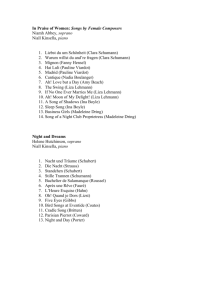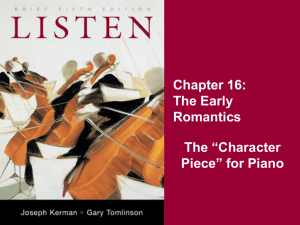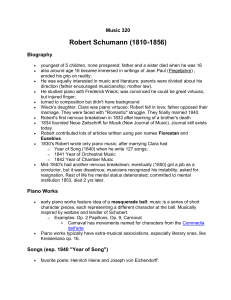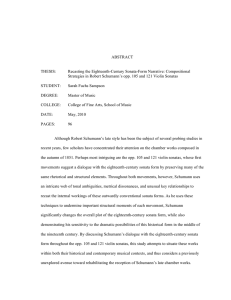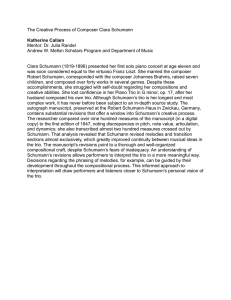21M011 (spring, 2006) Ellen T. Harris Lecture VIII Frankenstein
advertisement
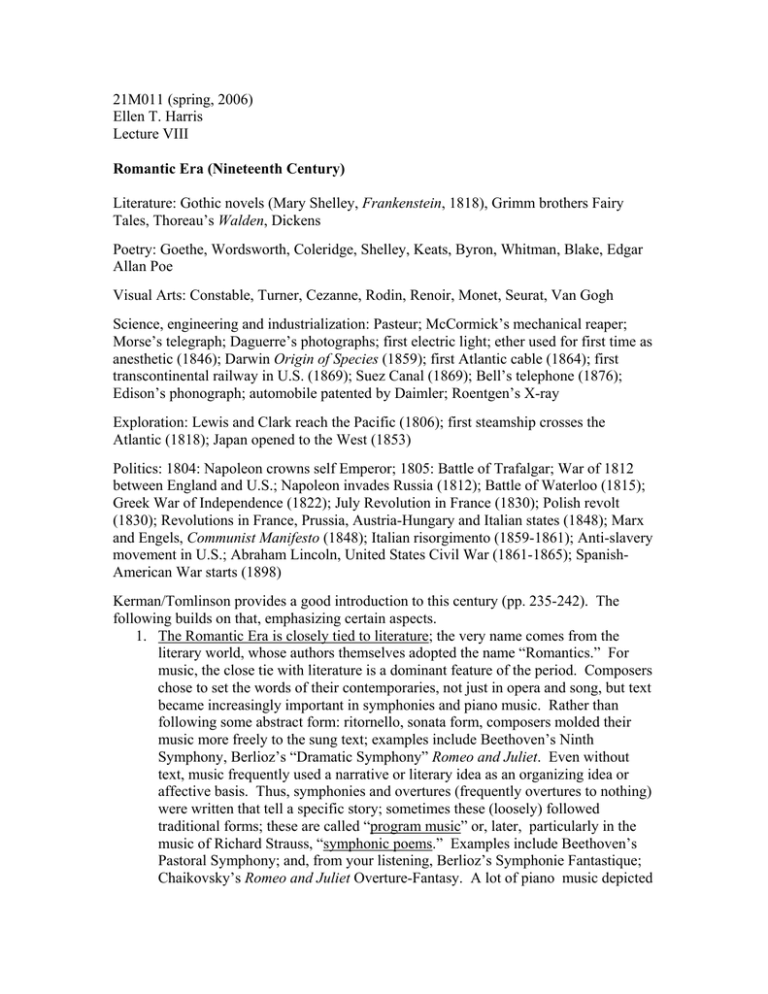
21M011 (spring, 2006) Ellen T. Harris Lecture VIII Romantic Era (Nineteenth Century) Literature: Gothic novels (Mary Shelley, Frankenstein, 1818), Grimm brothers Fairy Tales, Thoreau’s Walden, Dickens Poetry: Goethe, Wordsworth, Coleridge, Shelley, Keats, Byron, Whitman, Blake, Edgar Allan Poe Visual Arts: Constable, Turner, Cezanne, Rodin, Renoir, Monet, Seurat, Van Gogh Science, engineering and industrialization: Pasteur; McCormick’s mechanical reaper; Morse’s telegraph; Daguerre’s photographs; first electric light; ether used for first time as anesthetic (1846); Darwin Origin of Species (1859); first Atlantic cable (1864); first transcontinental railway in U.S. (1869); Suez Canal (1869); Bell’s telephone (1876); Edison’s phonograph; automobile patented by Daimler; Roentgen’s X-ray Exploration: Lewis and Clark reach the Pacific (1806); first steamship crosses the Atlantic (1818); Japan opened to the West (1853) Politics: 1804: Napoleon crowns self Emperor; 1805: Battle of Trafalgar; War of 1812 between England and U.S.; Napoleon invades Russia (1812); Battle of Waterloo (1815); Greek War of Independence (1822); July Revolution in France (1830); Polish revolt (1830); Revolutions in France, Prussia, Austria-Hungary and Italian states (1848); Marx and Engels, Communist Manifesto (1848); Italian risorgimento (1859-1861); Anti-slavery movement in U.S.; Abraham Lincoln, United States Civil War (1861-1865); SpanishAmerican War starts (1898) Kerman/Tomlinson provides a good introduction to this century (pp. 235-242). The following builds on that, emphasizing certain aspects. 1. The Romantic Era is closely tied to literature; the very name comes from the literary world, whose authors themselves adopted the name “Romantics.” For music, the close tie with literature is a dominant feature of the period. Composers chose to set the words of their contemporaries, not just in opera and song, but text became increasingly important in symphonies and piano music. Rather than following some abstract form: ritornello, sonata form, composers molded their music more freely to the sung text; examples include Beethoven’s Ninth Symphony, Berlioz’s “Dramatic Symphony” Romeo and Juliet. Even without text, music frequently used a narrative or literary idea as an organizing idea or affective basis. Thus, symphonies and overtures (frequently overtures to nothing) were written that tell a specific story; sometimes these (loosely) followed traditional forms; these are called “program music” or, later, particularly in the music of Richard Strauss, “symphonic poems.” Examples include Beethoven’s Pastoral Symphony; and, from your listening, Berlioz’s Symphonie Fantastique; Chaikovsky’s Romeo and Juliet Overture-Fantasy. A lot of piano music depicted specific images or characters rather than falling into the typical movement plan of the sonata: from your listening, examples include Schumann’s Carnaval and Chopin’s Nocturne. The tie to literature affects all aspects of music, but may be most important in terms of loosening form. 2. The Romantic Era is closely tied to the individual: poetry, art and music strove in the nineteenth century to represent individual feeling and emotion. This had many effects on music of this century, one of which is the importance of the composer’s life to his music, This is apparent in large-scale works, such as Beethoven’s Symphony No. 5, Berlioz’s Symphonie Fantastique, and Wagner’s Tristan. It also played an important part in the rise of the miniature. This repertoire includes principally songs and piano pieces, frequently lasting only a few minutes, depicting sometimes intense, sometimes fleeting emotions. Sometimes composers grouped a lot of these into a larger set; in the case of songs, these sets combined the miniatures into a longer narrative. The song was dominated in the nineteenth century by German composers; examples from your listening include Schubert, and Robert and Clara Schumann. As a result, the song is often known by its German name: Lied or, plural, Lieder. Piano miniatures are frequently called character pieces, since they depict a single character or mood; more often than songs, these are grouped into sets. Examples include Mendelssohn’s Songs Without Words; Chopin’s Etudes and Preludes (like many of the symphonic overtures, these preludes preceded nothing); and, from your listening, Chopin’s Nocturnes, Schumann’s Carnaval and Mussorgsky’s Pictures at an Exhibition (first written for piano and then orchestrated). [This aspect of the Romantic also tied to Revolution: Chopin, Wagner, Verdi] 3. The Romantic Era is closely tied to the supernatural and macabre: as Kerman/Tomlinson puts it, this fits in with the effort to transcend the ordinary and the conventional. Goethe’s Faust and Shelley’s Frankenstein mark the beginning of the Romantic fascination with the supernatural, which also finds strong voice in such disparate authors as the Grimm brothers (fairy tales), Blake, and Edgar Allan Poe. Music reacted strongly to such literature, ranging from Mendelssohn’s inimitable depiction of the fairies in his “Overture to Midsummer Night’s Dream” to Saint-Saëns Danse Macabre. Operas frequently used supernatural stories, like Verdi’s setting of Macbeth or Wagner’s Flying Dutchman about a ghost ship whose crew need the redemption of love to find eternal rest. Examples from your listening include Schubert’s setting of Goethe’s Erlkönig, Schumann’s Die alten, bösen Lieder, and Berlioz’s Symphonie Fantastique, which conjures up a nightmare of witches. Related to the attraction to the supernatural is a fascination with boundless nature, which, as Kerman/Tomlinson states, is sometimes menacing. This sense of the overwhelming and the desolate in nature is depicted, on the one hand, by the artist Turner and, on the other, by the poet Sir Walter Scott, who dramatized old Scottish tales and ballads set in the Scottish lowlands and highlands; Turner began his career painting scenes for opera, and Scott’s works formed the basis of operas by Donizetti (Lucia da Lammermoor), symphonic poems by Berlioz (Waverly and Rob-Roy) and some extraordinary songs by Schubert (Lady of the Lake). Style characteristics: Texture: melody with accompaniment dominates; frequently very thick as opposed to the clarity of the Classical era Timbre: piano a dominant instrument (Lied, character piece, concerto); individual tone color of single instrument; unique combinations of instruments (less focus on orchestral sections: strings, woodwinds, brass) Harmony: tonal, but with a weaker sense of key center due to chromaticism, fusion of major and minor modes, deceptive cadences, modal harmonies of folk song; use of harmony and specific sonorities to create mood Rhythm: less regular: complex and rhapsodic (Chopin using groups of 5 or 11 notes to a beat, for example); rubato (flexible tempo) Melody: less regular: fragmentary or very extended (use of chromaticism, dynamic climaxes) Form: less regular: less dependence on standard forms, freer shapes of ballade or fantasy, overlapping with vague boundaries, BUT use of motivic repetition or thematic transformation to create cyclic forms (Schubert, Erlkönig; Berlioz, Symphonie fantastique) Romantic miniatures Terms lied, lieder accompaniment through-composed strophic modified strophic song cycle character pieces nocturne rubato strain Piano repertoire: Character pieces for piano: short piano works that convey a certain mood or character, frequently given generic titles: preludes, ballades, nocturnes, etudes, etc. Schubert, Moment Musical title is picturesque and poetic, creating no expectation other than brevity. Sometimes these small forms gave composers a chance to experiment with juxtaposition of materials and with structures without formal patterns. Compare to Berlioz, Fantastic Symphony, fifth movement, where the form is created in response to the drama. 1. No. 2 in A-flat K 4:1 Starts out basically ABA′, and the piece could clearly end at this point. The return of B in a new key and fortissimo is an anguished interruption/extension that the next return of A cannot entirely quell—will it come back again after the return of A with its coda? A (a a′) B 0:00 0:35 1:20 A′ (a′′ coda) 2:23 3:17 | | B′ 3:57 A′′ 4:54 coda 5:36 Sometimes there is a close connection to the dance. 2. No. 3 in F minor (Kerman CD-Rom 10) The use of three “strains” (a discrete or characteristic section or tune in dance or march music) is similar to the form of the Renaissance galliard Daphne in your listening, but even in such a small piece, there are other formal connections: (1) minuet-trio and (2) ABA coda. The complexity of such little pieces can be astonishing, and close readings offer multiple interpretations. intro 0:00 |: a :| 0:03 min. |: b :| 0:26 Maj. |: c :| a 0:49 1:14 m->M other readings: |: a :| |: b :|: cb :| A B d 1:25 a (coda) A Æ a′ 1:42 coda (3 strains plus coda) (“minuet/trio”) (ternary) Schumann, Carnaval A collection of miniatures representing masked revelers at Carnival (festival in advance of the period of penitence before Easter called Lent—e.g. Mardi gras = last day of Lent) Schumann represents characters from improvised Italian comedy (commedia dell’arte), Schumann’s friends and colleagues, and Schumann himself. “On 8 June (his 21st birthday) Schumann wrote in his diary: ‘It sometimes seems … as if my objective self wanted to separate itself completely from my subjective self, or as if I stood between my appearance and my actual being, between form and shadow’ ” (John Daverio, “Robert Schumann,”Grove Music Online, ed. L. Macy). In his musical criticism, Schumann signed himself by two distinct names: Eusebius (=thoughtful dreamer, introspective) Florestan (=impetuous and mercurial, prone to mood shifts, extrovert) The full title of this collection is Carnaval: scènes mignonnes sur quatre notes: these notes are A, E flat, C, B natural or A[E]s C H in German (see #10 of the set, below). ASCH = name of town where Schumann’s fiancée, Ernestine von Fricken, lived or Robert Alexander SCHumann SCHA = SCHumAnn ASCH = Ash (Ash Wednesday, first day of Lent); FASCHing = carnival Kerman/Tomlinson implies by its wording that the abrupt, non-ending of the Florestan movement leads directly to Chiarina (representing Clara Wieck, who would become Schumann’s wife), but at this time Clara was only 13, and Schumann was engaged to Ernestine. But beyond all of these facts, as the list of movements indicates, the tempestuous Florestan movement leads directly to Coquette—a very different implication. Schumann, Carnival (depicts masked revelers at Carnival) 1. 2. 3. 4. 5. 6. 7. 8. 9 10. 11. Preamble Pierrot Harlequin Noble Waltz Eusebius (poetic Schumann) Florestan (passionate Schumann) Coquette Rejoinder Butterflies (the title of an earlier piano cycle by Schumann ASCH-SCHA: Dancing Letters Chiarina (Schumann's beloved Clara) 12. 13. 14. 15. Chopin Estrella (Baroness E. von Fricken) Recognition ("Reconnaissance") Pantalon and Columbine 16, 17. 18. 19. 20, 21. German Waltz-Paganini German Waltz Confession of Love Promenade Pause – March of the League of David against the Philistines (including sections of the Preamble, no. 1) “Eusebius” K 4:2 like Schubert’s Moment Musical, Eusebius has multiple formal implications; note moreover, that a and b are not distinctively different. Motive a blurs the beat by using 7 equal notes per measure; motive b enlarges the upward intervallic leap and breaks the measure into two parts, the first divided into 5 equal notes, the second 3 equal notes. Motive a is accompanied by a rising chromatic line in the bass; motive b by a descending chromatic line. If the movement were simply |: a :|: ba :| it would, obviously, be in rounded binary form, but the interruption of the extra ba with thicker chords creates a disruption in that formal scheme similar to the disruption in Schubert’s Moment Musical No. 2 in A-flat that also expands what seems a conventional form. a 4 0:00 a 4 |: a :| ba A b(=a′) a 4 4 0:23 b a b 4 4 4 0:52 1:19 fuller, thicker chords BA ba B A′ a 4 (rounded binary with loud disruption) (ternary with only texture and dynamic contrast) “Florestan” K 4:3 an impetuous single theme movement with “nostalgic” interruptions (indicated by a ‘p’ in the chart below) from an earlier collection of piano pieces by Schumann, Papillons (1831), based on a scene of a masked ball in a novel (Flegeljahre by Jean Paul); “papillons” = butterflies, which relates to the theme of transformation inherent in the masking. Form: a [p] a [p] a |: b :| b’ a’ Timings: 0:00 0:11 0:26 0:51 # of measures: 8 2 8 4 8 |: 8 :| 8 12 section form: aaba aaba aaba caca ccc′c′ a a ASCH-ASCH 224 4 Chopin, Nocturne in F-sharp, Op. 15, No. 2 K 4:4 Nocturne = night piece (serenade? lament?); the blurring of the beat that occurs in Schumann’s “Eusebius” is an inherent part of Chopin’s style and enhanced by extensive use of rubato, a flexible adherence to tempo that allows for slowing down and speeding up. Chopin’s use of groups of 3, 5, 6, 7 (and at one point 30!) notes over the space of 1 to four measured notes creates a completely liquid sound on the surface. The underlying structure, however, is amazingly regular and based on 8-bar phrases. a a′ b c a′′ coda 0:00 0:26 0:57 1:27 2:13 2:54 A B A Chopin, Ballade No. 3 in A-flat major Performed by Lindy Blackburn, G (Physics), pianist 1. the “ballade” partakes of the piano miniature in its freedom of form, but is typically bigger in length and substance 2. the term “ballade” derives from song and refers to a narrative that typically takes strophic form (Der Erlkönig is a ballade) 3. Chopin wrote four ballades Ballade No. 3 in A-flat major A B a legato (smooth) theme moving largely by step; it takes the shape of a ternary statement: aba a more lively theme off the beat (syncopated); it also takes a ternary shape: cdc C a true “central section” in the mode of a waltz; Chopinesque flowing notes B return and extended development A fortissimo return with much thicker texture (think of the similarly “thickened” passage in Schumann’s Eusebius) C coda using C material Recording: Great Pianists of the 20th Century, vol. 85, Artur Rubinstein, piano (Philips Classics, 1998) Song Repertoire: read Kerman/Tomlinson; some emphases and additional points below Performed by faculty members Ellen Harris (soprano) and Charles Shade (piano) Clara Schumann: “Der Mond kommt sill gegangen” K 3:25 poem in three strophes musical setting is in modified strophic form the first two strophes are set alike, but the third differs some reasons for the change: the first two strophes speak of the atmosphere; the third is a personal statement the third strophe has more syllables while maintaining the same poetic foot (or accent pattern) the first two strophes end reaching out, drifting; the third strophe “could” end this way and “could” in fact be set to the same music as the first two (as demonstrated in class), but this would give the song an inconclusive ending and poor text setting the changes to the third strophe include: a lengthening of note value for the word “drunten” (down below); a quickening of note values on “funkeln” (flickering candle light), a melodic climax (high note) on the reference to the loved one’s house (“Haus”); a fragmented descent through the darkness and stillness (“Dunkeln” and “Still”) to a definitive (and therefore somewhat desolate) closure on “Welt hinaus” (the staring “out to the world”). Robert Schumann: “Im wunderschönen Monat Mai” K 3:23 the first song from the song cycle Dichterliebe (“A Poet’s Love”); the poems by Heinrich Heine poem in two stanzas musical setting is strophic the accompaniment blurs the main beat by anticipating it with a single note that is then held over and not articulated on the beat--this happens repeatedly; the accompaniment also repeatedly uses a melodic fragment that makes an upward leap that goes a little “too far,” so creates a dissonance that needs to “relax” downward by step; this melodic motion feels like yearning or longing and is often used to depict the same; the same kind of occurs at the opening of “There’s a place for us” in West Side Story (on “There’s a place” with the resolution on “place”); the motion is also distinctive of the “love-death” motive of Wagner’s Tristan und Isolde, on the listening for next week the song doesn’t “end” in the sense of having a conclusive cadence; it just reaches out (yearning) on a chord that asks for resolution Robert Schumann: “Die alten, bösen Lieder” K 3:24 the last (16th) song of Dichterliebe; the love and yearning have not been reciprocated; this song depicts the lover’s reaction: he wants to build a huge coffin in which to put all the “old, hateful love songs” and describes just how big; he then explains why it has to be so large: it will hold not just the songs but he will bury in it all his love and grief poem in 5 stanzas musical setting is through-composed; that is, it doesn’t follow the strophic pattern or any other pre-determined form the first stanza sets the scene and Schumann sets the text with a highly profiled and accented set of downward leaps; the repeated strong downward pulls emphasize the dismissiveness, throwing away, burying of the text stanzas 2-4 describe “how big”; each climaxes with a leap upward and with each strophe the motion moves up one scale degree (the higher and higher notes depicting a bigger and bigger stretch) stanza 5 returns to what has to happen to the coffin; Schumann here returns to the music of the opening strophe (varied) stanza 6 (like the last strophe of Clara Schumann’s song) brings in the individual, the use of first person, and here the music changes completely from the hammering dismissiveness to quiet reflection (recitative-like) and disintegration (fragmentation) rather than end on this note, Schumann provides a substantial piano postlude; remember that this is a postlude not just to one song, but to the set of 16; Kerman/Tomlinson suggests that it is meant to comfort the poet; I rather think that its repeated downward motion reaches back to the brutal downward motion of the opening of this song, now transformed from the initial angry mood into the personal grief expressed in the last strophe Schubert, “Erlkönig” K 3:22 an individual song composed by Schubert at 18 poem in 8 stanzas by Goethe the poem is rich in the use of form and style to depict its story: the rhythm of the wild night ride through the woods is clearly heard in the rhythm of the poetic meter (as read in class); the strophes are set up to indicate the progress of the story: stanza 1, the narrator sets the scene; stanza 2, the father asks what troubles his son, the son identifies the Erlking, and the father dismisses the notion; stanza 3, the Erlking entreats the boy to come with him and play games in a beautiful place; stanza 4, the boy cries out to his father who tries to calm the boy; stanza 5, the Erlking entreats the boy to come sing and dance with his daughters; stanza 6, the boy cries out again and the father again offers empty consolation; stanza 7, the Erlking, having lost patience, reaches out and grabs the boy by force, who cries out for the last time (this is the first time that the Erlking and the boy have shared a stanza; it indicates the coming together of death and the boy; the father doesn’t respond; it is as if the Erlking has replaced the father); stanza 8, the narrator describes the arrival at home and the death of the boy Clearly the poetic meter, rhythm, strophic form and characterization are all important elements of the poem; as a result, Goethe liked settings that preserved all of this; an example of such a setting by Johann Friedrich Reichardt (1752-1814; about the same lifespan as Haydn); this setting uses strict strophic form, but the voice sings in monotone (one note) for the Erlking’s part while the piano continues to play the melody; this was Goethe’s favorite setting (performed in class) Schubert’s setting puts the rhythm of the poem in the piano (the pounding hoofbeats of the horse); as a result the rhythm of the poem is often drained from the setting of the words; the father’s part lies low in the voice; the boy’s part lies high; the father’s part is often accompanied by “empty” octaves, depicting his “empty” consolation; the Erlking sings in major and tries to entreat the boy with jolly melodies, but the boy cries out in pain, set by Schubert to a searing dissonance, and each of his three responses rises higher as if the pain thus increases (compare Schumann’s use of this rising technique to depict ever bigger); the Erlking’s last lines are brutal and declamatory (no more pretended sweetness); the last strophe returns to the rushing wind motive of the opening as the father drives the horse faster and faster; Schubert depicts the arrival at home, the slowing and stopping, and then drops into the most quiet and unembellished recitative to state that when the father arrived home, the boy was—dead; and the song ends; the abruptness of this ending adds to the shock; Goethe heard this setting but disapproved as the music completely overwhelms the poem and its distinctive compositional methods
